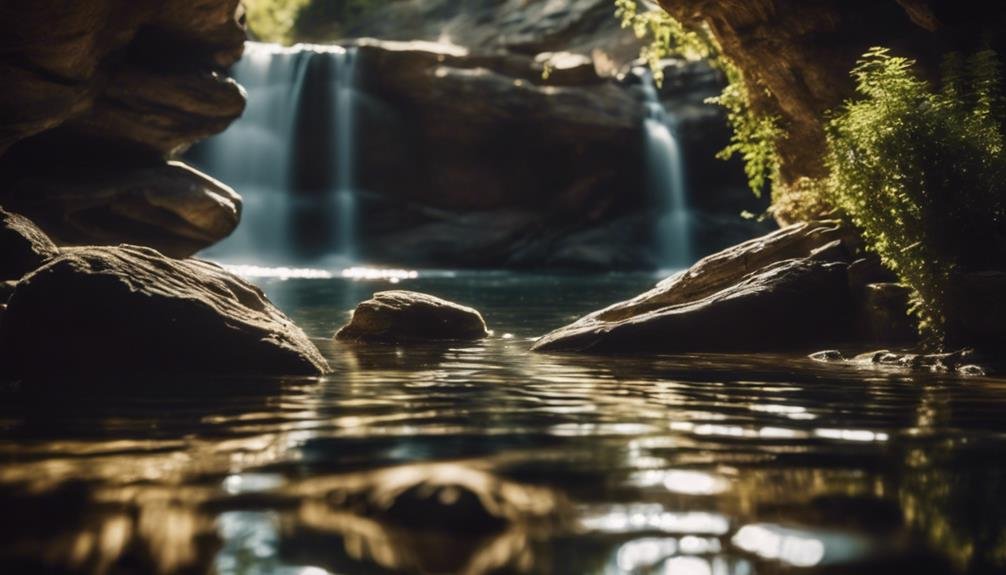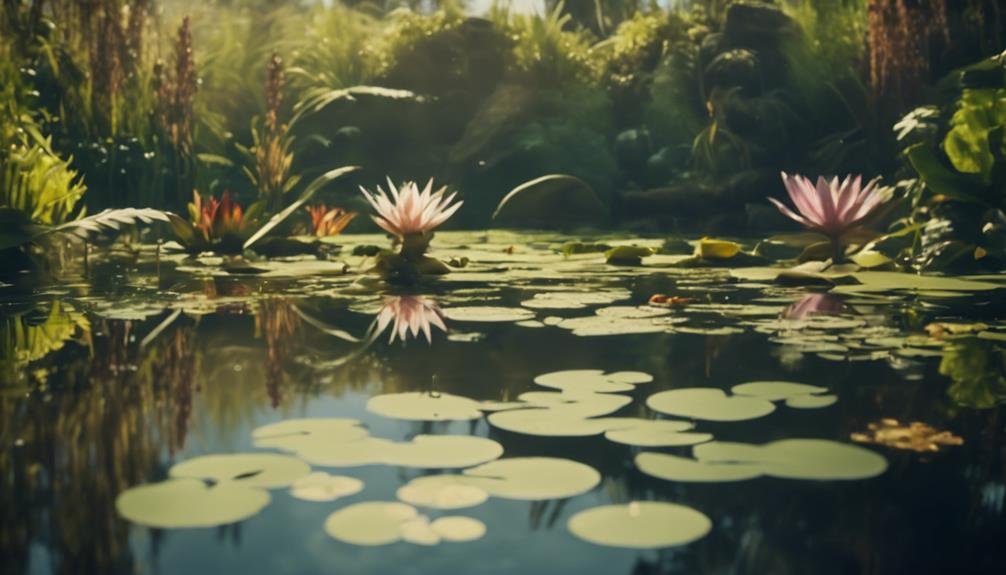To start building a self-sustaining pond ecosystem, you need to find a suitable location that receives plenty of sunlight, has clay-based soil, and is close to a water source. Once you've chosen the site, it's time to dig out the pond area and line it with a material that is waterproof. Don't forget to install essential equipment like pumps and aerators to keep the water circulating properly. Adding features like fountains and waterfalls will help maintain a consistent flow and oxygen levels in the pond.
Aquatic plants play a crucial role in balancing the ecosystem of your pond. They provide oxygen, absorb excess nutrients, and create shelter for various wildlife. By strategically placing these plants, you can ensure a thriving and low-maintenance pond environment.
Overall, creating a pond with the right conditions will attract a diverse range of aquatic organisms, enhancing the overall ecosystem of your pond.
Site Selection
When selecting a location for the pond, it's crucial to consider key factors like sunlight exposure, proximity to a water source, and soil composition to ensure its long-term viability. Opt for a spot that receives plenty of sunlight to promote healthy plant growth and oxygen levels. Having a nearby water source, such as a stream or well, is essential for maintaining consistent water levels and replenishing any losses due to evaporation. Look for clay-based soil or soil with a high clay content to prevent excessive water seepage.
Furthermore, evaluate the slope and potential runoff to prevent excessive rainwater inflow that could disrupt the pond's delicate ecosystem. It's wise to position the pond away from trees or structures that may shed leaves or debris, as they can lead to nutrient buildup and algal blooms.
Pond Construction
Constructing a pond requires meticulous planning and attention to detail. The process begins with excavation, creating a hole with gently sloping sides to accommodate different water depths and prevent erosion.
Once the area is dug out, it's essential to line it with a durable, water-resistant material like a pond liner or bentonite clay to prevent leaks.
After securing the liner, the next step is to install essential equipment for the pond, such as a water pump and filtration system, aeration devices like fountains or bubblers, underwater shelves for aquatic plants, and natural features like rocks or logs to enhance habitat diversity.
Ensuring the right depth is crucial, with deeper areas (3-6 feet) providing cooler temperatures for fish and shallower zones (1-2 feet) allowing sunlight to reach aquatic plants for optimal growth.
Water Circulation

Proper water circulation is essential for maintaining a healthy pond ecosystem. It's crucial to keep the water moving and flowing to prevent stagnation and the growth of harmful bacteria and algae.
One effective way to achieve this is by installing a pond pump and fountain. The pump draws water from the bottom of the pond and sprays it back onto the surface, creating a continuous cycle that helps aerate the water by allowing oxygen to dissolve into it.
Another option is to incorporate a waterfall or stream into the pond design. The constant flow of water over rocks and ledges naturally aerates and circulates the water. Positioning the stream inlet and pond outlet at opposite ends can help maintain a consistent flow pattern.
Plants Integration
To maintain a healthy pond ecosystem, we'll strategically place aquatic plants to support water circulation and biodiversity. These plants play a crucial role in balancing the pond's ecology by providing oxygen through photosynthesis, absorbing excess nutrients to prevent algae growth, and offering shelter and breeding grounds for aquatic organisms.
Additionally, they aid in water filtration by filtering out impurities and contaminants with the help of their roots and associated microorganisms.
Wildlife Attraction

Creating a well-balanced pond ecosystem can attract a variety of wildlife, increasing biodiversity in the area. To encourage birds, amphibians, and beneficial insects to visit and potentially make the pond their home, we can incorporate specific features. Planting vegetation around the edges of the pond provides nesting sites and shelter for birds and small mammals.
Additionally, adding logs or rocks protruding from the water offers frogs and turtles a place to bask in the sun. It's crucial to ensure a reliable water source for animals to drink from. In case the pond dries up during hot summer months, we may need to supplement it with additional water.
Avoiding the use of pesticides or chemicals near the pond is essential, as these substances can be harmful to the wildlife we aim to attract. By creating a safe and resource-rich environment, the pond can become a thriving oasis for a variety of fascinating creatures. With careful planning and patience, we can establish a beautiful, self-sustaining ecosystem bustling with life.
Conclusion
By carefully planning and implementing each step, we can create a stunning pond ecosystem that even Mother Nature would admire – a bustling aquatic habitat teeming with life, a true haven for biodiversity right in our own backyard.
By diligently following these steps, our self-sustaining pond will become a peaceful and fascinating oasis that will last for years to come.
To start, we must carefully select a suitable location for our pond, ensuring it receives adequate sunlight while also providing some shade to prevent excessive algae growth.
Next, we should excavate the area to create the desired shape and depth for our pond, making sure to include shelves for different aquatic plants.
Once the pond is in place, we can begin adding a variety of aquatic plants such as water lilies, hornwort, and duckweed to provide oxygen, shelter, and food for the aquatic life. Introducing fish like koi or goldfish can also help maintain a healthy balance within the ecosystem by controlling algae and insect populations.
To further enhance the biodiversity of our pond, we can encourage the presence of beneficial insects like dragonflies and water beetles. Additionally, installing a small waterfall or fountain can help aerate the water and create a soothing ambiance.
Regular maintenance, such as removing debris and controlling algae growth, is essential to keep our pond ecosystem healthy and thriving.
By investing time and effort into our self-sustaining pond, we can enjoy a slice of nature's beauty right in our own backyard, a tranquil retreat that brings joy and wonder to all who encounter it.

